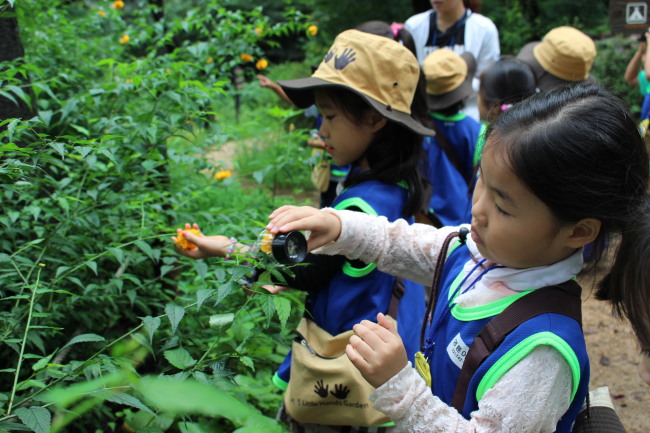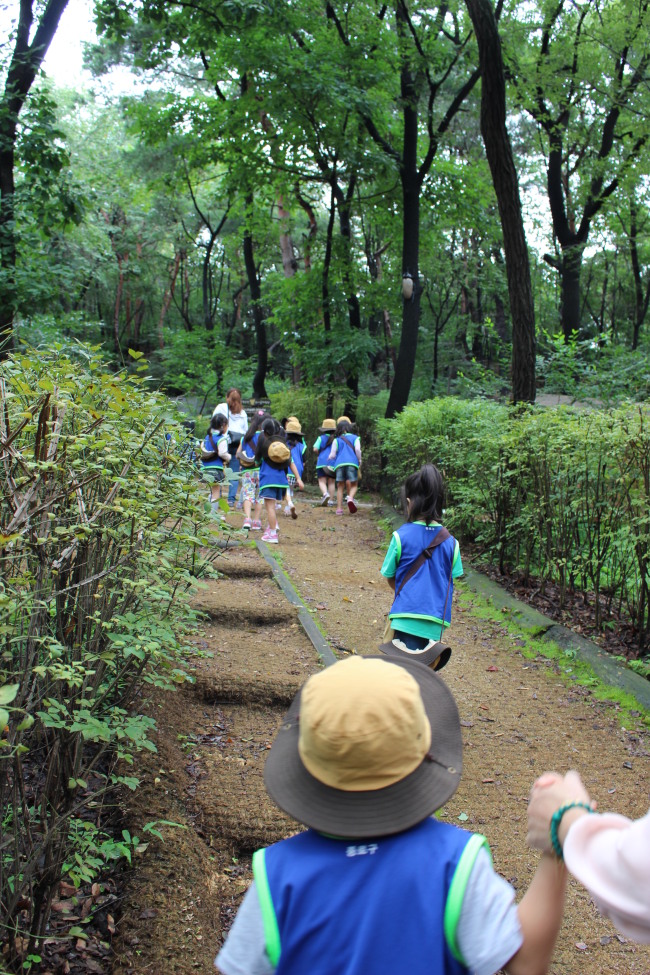“Take a look at this pupa hanging from a leaf.”
At the call of the guide, 5-year-olds crowded around to observe the cocooned insect hanging from a shrub inside the “infant’s forest” of Samcheong Park, in the center of the country’s busiest city, Seoul.
Each with a magnifying glass in hand, the children freely explored their surroundings, poking at a slug and shrieking in delight at finding a spider hanging on a web in a tree.
Amid the drone of city life and strictly planned classroom culture, more parents are turning to educating their children in forests, where they can roam freely through nature.
Seoul Metropolitan City was the first local government to create forests for children in 2011. There, instead of toys and books, nature provides the learning materials. Adults are only there to assist.
At the call of the guide, 5-year-olds crowded around to observe the cocooned insect hanging from a shrub inside the “infant’s forest” of Samcheong Park, in the center of the country’s busiest city, Seoul.
Each with a magnifying glass in hand, the children freely explored their surroundings, poking at a slug and shrieking in delight at finding a spider hanging on a web in a tree.
Amid the drone of city life and strictly planned classroom culture, more parents are turning to educating their children in forests, where they can roam freely through nature.
Seoul Metropolitan City was the first local government to create forests for children in 2011. There, instead of toys and books, nature provides the learning materials. Adults are only there to assist.

“We sought to break the monotonous learning culture of children being trapped inside classrooms, and to foster the creativity of children by allowing them to explore nature and mingle with one another on their own,” Bae Si-yeon, the manager of the city project, told The Korea Herald.
The city’s forest playgrounds are located in urban parks and woodlands, with 41 of them in Seoul now. The goal is to create 400 such places by 2023 and offer wider access to the city’s 7,500 infant education institutes.
From 2012 to 2016, over 51,000 citizens visited the educational forests, according to the city’s data.
This year, the city started a program that regularly invites classes from 200 local kindergartens to visit the parks once a week.
“It would be nice if more children got the chance to play in forests, and we encourage that. But our program aims to bring in the same children regularly to the forests to see their development,” Bae said.
Seoul hires at least one special instructor in each park to lead kids in different programs, but their roles are meant to assist, not to lead the children’s play.
“There are a lot of things a child can learn from nature. They learn to respect and cooperate with others in the forests, where they help each other walking up the hills and when they meet small challenges,” said Lee Kyung-a, the head of Myungrun Care Center in Jongno. The kindergarten has been participating in the program since February.
“It is important that these children are exposed to nature at this stage when their characters and moral standards start to develop,” she added.
As the kindergarteners lined up to walk on the soil wet from yesterday’s rain, the area was filled with endless questions about spider webs, flowers and red ants.
According to Heinz Hafner of the University of Heidelberg in Germany, children who graduate from forest kindergartens, or “Waldkindergarten” in German, show superiority in cognitive tasks and controlling their emotions. Many researchers and experts also back the idea that children exposed more to nature in their childhood show high scores in creativity and physical ability.

Six months into the program, Lee has seen a change in the mindsets of parents who were initially unsure about forest education.
“Many parents are very worried about the safety of the children. Some do not like their kids playing in dirt, and others worry about insect bites. But the parents in my institute have become much more enthusiastic about forest trips, as they see their children becoming brighter and more talkative about their days in kindergarten,” Lee said.
Aware of such benefits, Kindergartens and nurseries have added more activities involving greenery in their curriculums.
The Korea Association of Forest Kindergartens, which kicked off in 2010, now has 762 member kindergartens across the nation, with 92 of them located in Seoul.
Lee Il-hwan, who came to drop his daughter off at the park, said he was satisfied with the forest education.
“It is good to see children mingling with nature, insects and animals, and it is much better than commercialized playgrounds. Children observe the seasons changing with their own eyes,” the 34-year-old father said.
Shin In-san, 5, took a break from making a stone and twig insect house to say how much he likes the forest.
“Making houses for insects is fun. I want to come to the forest every day,” he said.
By Jo He-rim (herim@heraldcorp.com)








![[Graphic News] More Koreans say they plan long-distance trips this year](http://res.heraldm.com/phpwas/restmb_idxmake.php?idx=644&simg=/content/image/2024/04/17/20240417050828_0.gif&u=)
![[KH Explains] Hyundai's full hybrid edge to pay off amid slow transition to pure EVs](http://res.heraldm.com/phpwas/restmb_idxmake.php?idx=644&simg=/content/image/2024/04/18/20240418050645_0.jpg&u=20240419100350)






![[From the Scene] Monks, Buddhists hail return of remains of Buddhas](http://res.heraldm.com/phpwas/restmb_idxmake.php?idx=652&simg=/content/image/2024/04/19/20240419050617_0.jpg&u=20240419175937)

![[KH Explains] Hyundai's full hybrid edge to pay off amid slow transition to pure EVs](http://res.heraldm.com/phpwas/restmb_idxmake.php?idx=652&simg=/content/image/2024/04/18/20240418050645_0.jpg&u=20240419100350)

![[Today’s K-pop] Illit drops debut single remix](http://res.heraldm.com/phpwas/restmb_idxmake.php?idx=642&simg=/content/image/2024/04/19/20240419050612_0.jpg&u=)